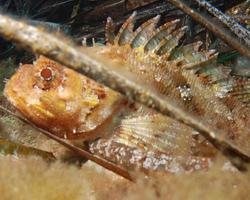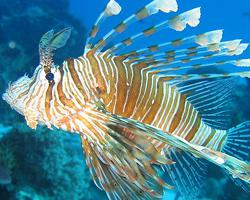
Greutăți și măsuri
| Lungime | 25 cm |
|---|---|
| Greutate | 870 g |
Starea de conservare
| Amenințat |
Descrierea animalului
The Black scorpionfish, scientifically known as Scorpaena porcus, is a captivating marine species belonging to the Scorpaenidae family. This intriguing creature is widely distributed across the Eastern Atlantic Ocean, including the Mediterranean Sea, the Black Sea, and along the coastlines from the British Isles to the Canary Islands. The Black scorpionfish is particularly renowned for its unique appearance and its ability to blend seamlessly with its surroundings, making it a master of camouflage.Physically, the Black scorpionfish is a medium-sized fish, typically reaching lengths of up to 30 centimeters, although some specimens can grow larger. Its body is robust and covered with venomous spines, which serve as an effective defense mechanism against potential predators. The skin of the Black scorpionfish is rough and adorned with numerous small, wart-like protrusions, adding to its rugged appearance. The coloration of this species is predominantly dark, ranging from shades of brown to black, with mottled patterns that mimic the rocky and sandy seabeds where it dwells. This natural camouflage enables the Black scorpionfish to remain virtually invisible to both prey and predators.
One of the most distinctive features of the Black scorpionfish is its head, which is large in proportion to its body and equipped with a wide mouth. The mouth contains several rows of sharp teeth, capable of grasping and holding onto slippery prey. Above the mouth, the eyes are set high, providing the fish with a broad field of vision to detect food and predators. The dorsal fin of the Black scorpionfish is equipped with venomous spines, which the fish erects when threatened to deter attackers. The venom can cause severe pain and swelling in humans, making it advisable to handle this fish with caution.
The Black scorpionfish is a solitary creature that prefers rocky bottoms, coral reefs, and seagrass beds, where it can easily hunt and hide. It is primarily nocturnal, spending the daylight hours concealed among rocks or buried in the sand, emerging at night to feed. Its diet consists mainly of small fish, crustaceans, and mollusks, which it ambushes with remarkable speed and precision.
Reproduction in the Black scorpionfish occurs through the release of eggs and sperm into the water column, where fertilization takes place externally. The eggs are pelagic, meaning they float freely in the ocean currents until they hatch into larvae. These larvae eventually settle on the ocean floor and grow into juvenile fish, completing the life cycle of the species.
The Black scorpionfish, with its venomous spines, cryptic appearance, and fascinating behavior, is a remarkable testament to the adaptability and diversity of marine life. Its presence in the marine ecosystem plays a crucial role in controlling the population of smaller fish and invertebrates, maintaining a balanced and healthy ocean environment. Despite its venomous nature, the Black scorpionfish is also appreciated by some as a delicacy, though care must be taken in its preparation to avoid the effects of the venom. As a subject of scientific interest and a marvel of natural engineering, the Black scorpionfish continues to intrigue and captivate those who encounter it in the wild waters of the Atlantic and beyond.
Animale similare
Fotografii noi cu animale
Top 10 animale
- Dolphin gull (Leucophaeus scoresbii)
- Diana monkey (Cercopithecus diana)
- Moustached guenon (Cercopithecus cephus)
- Galápagos tortoise (Geochelone nigra complex)
- Stone loach (Barbatula barbatula)
- Japanese macaque (Macaca fuscata)
- Greek tortoise (Testudo graeca)
- Russian tortoise (Testudo horsfieldii)
- Common flying dragon (Draco volans)
- Galápagos penguin (Spheniscus mendiculus)


